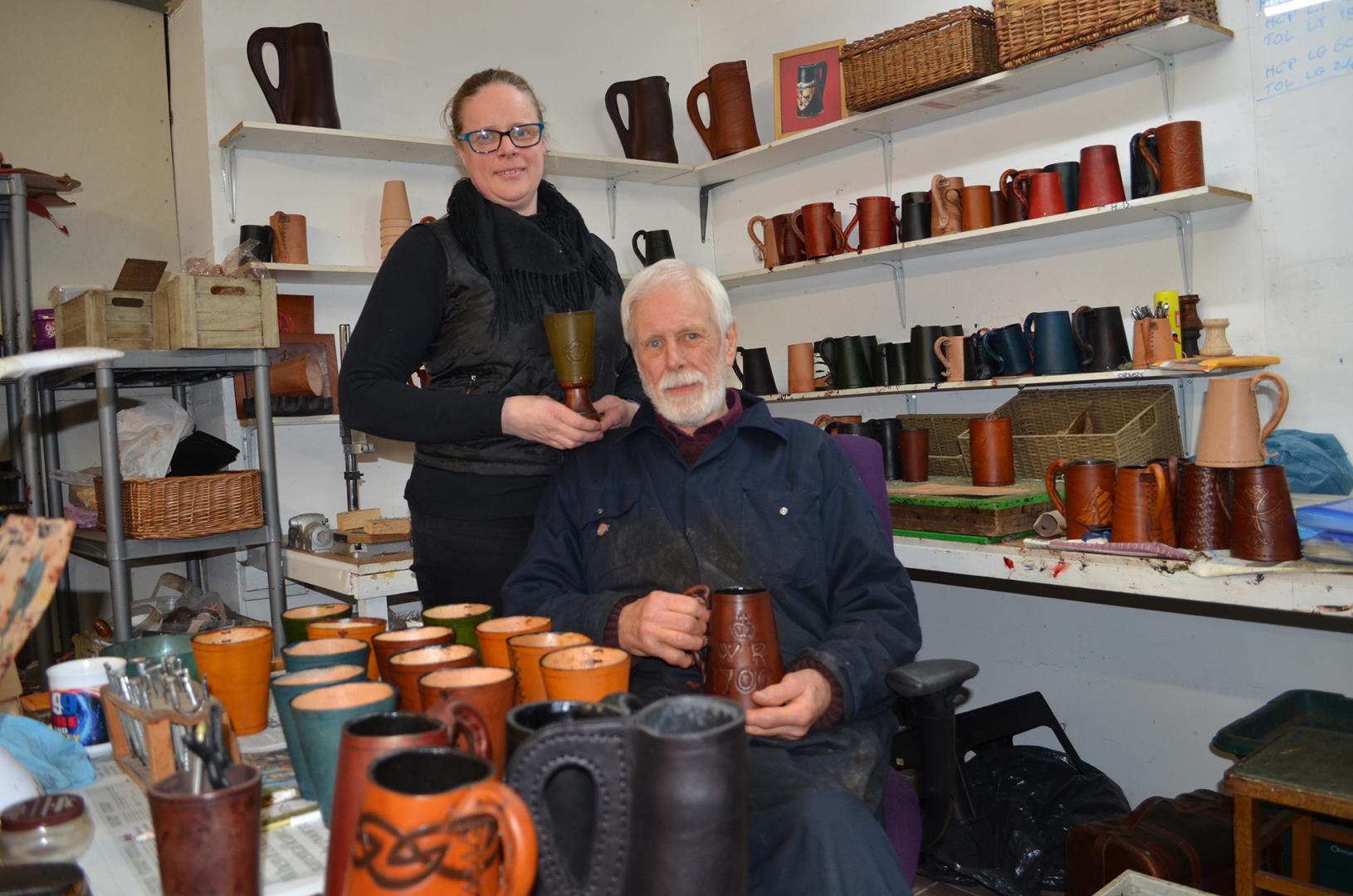For the past 25 years Hidebound, based in Quaker’s Yard, Newgate, in Barnard Castle, has produced a range of traditional handmade leather tankards, goblets, jacks and bombards for customers around the world. Reporter Nicky Carter popped along to the premises
IN an unobtrusive yard, a team of craftspeople are keeping alive centuries-old traditions and their handmade leather drinking vessels have become the toast of Hollywood, featuring in a multitude of blockbuster films.
Hidebound was started by Stephen Roberts, who said he had no experience of “working with his hands” , but after retiring as a chartered surveyor he wanted something to keep him busy.
A friend introduced him to a leather worker who was creating drinking vessels and an idea was born.
At first, Mr Roberts and friend Gillian Sewell helped to sell the products made by the man, who was from Manfield, near Darlington, at a number of markets and shows.
But it wasn’t before long that they began creating their own.
He said: “At first we were working out of spare rooms in each of our homes and running backwards and forwards.
“After a while we got a workshop in Bowes, but have been in Barnard Castle for some time now.”
In the intervening years Mr Roberts and his team have become fonts of knowledge on the history and evolution of leather drinking vessels, easily explaining the subtle differences between a jack and a tankard (see note at the bottom right). They are also highly regarded by other traditionally-trained leather workers for their often ingenious ways of working.
Demand for the tankards has been growing steadily over the years and they say their products are known more internationally than locally in Teesdale.
Mr Roberts added: “Once someone sees them they really do fall in love with them – they are just so tactile and they are all made to traditional methods.”
Mr Roberts’ daughter, Sarah, who joined the company ten years ago, said although they retail the Jacks, tankards and goblets online they also wholesale them to larger organisations and are available for sale in Barnard Castle itself.
She added: “I was actually in the castle shop and mentioned to the lady there that we make them and she hadn’t realised. The funny thing is we ship them all the way to English Heritage in Croydon for them to send them back here to sell.”
The firm’s products, which come in a variety of finishes, with or without traditional motifs, are supplied to 74 English Heritage sites including the Tower of London and Hampton Court Palace.
Mr Roberts added: “Over the years they have featured in a number of films. We did a stock for the Pirates of the Caribbean film and they also ordered more for the sequels as well.
“We were commissioned to make a special flask for Snow White and the Huntsman.
“They wanted a flask that appeared to be breathing, which was fun to do. When they filmed it they had a guy off camera breathing into a tube to produce the effect.”
Their specialised goblets, which have birch wood bases, have also appeared in the hugely popular Game of Thrones television series.
Mr Roberts said: “In the opening episode, the first time you see Tyrion Lannister he is drinking wine from one of our goblets. We have just had a big order from Netflix as well, but they didn’t say which series they were going to be used for.
“We also got a phone call from the BBC about an order, but it’s very hush-hush at the moment – all we can say is it is a long-running favourite with a futuristic slant.
“A lot of people ask us what it’s like to make the tankards for films and honestly it’s no different to normal. We just box them up and ship them out.”
It’s a lengthy job to make the different vessels. It starts with a raw shoulder of leather, from which the components to make the tankards, goblets and jacks are cut.
Then traditional designs such as Tinners Rabbits, a circular motif of three hares which dates back more than 3,000 years, are carefully pressed into the leather by hand using traditional methods.
Ms Roberts said: “Once we’ve pressed the designs and punched holes for the stitching, we bag up the components and they’re sent up the dale.
“We’ve got three ladies who stitch them together and then they come back to us so we can put the liner in.”
When the black liners, which are formed using epoxy resin approved by the brewing industry, are dry, the final decoration can be added. This involves staining the leather and adding colour to the different motifs.
Ms Roberts added: “It’s relatively easy to clean with soap and water after use, as long as they’re not immersed in water.
“But they’re not dishwasher friendly.
“They are better than glass because if you drop them they won’t break. With our vessels if you drop them the liner will crack, but you can have that replaced.”
For more information on Hidebound, visit their website at hidebound.co.uk
Jacks and tankards
l A medieval jack was tubular in shape and had a separate handle attached. The term black jack refers to the black pitch used to make the leather watertight.
l A Tudor tankard had a large broad base providing more stability. All Hidebound’s tankards are modelled on those recovered from Henry VIII’s flagship Mary Rose, which sank in 1545.






